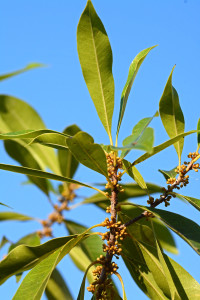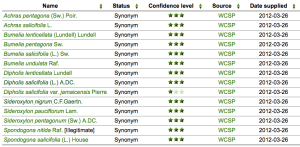On the first day of spring 2015 (that was March 20 for those of you who still aren’t keeping track of the seasons and astronomical events) I planted a new tree in the side yard out front: a Willow Bustic, Sideroxylon salicifolium. (Although take that taxonomic name with a grain of salt; apparently the tree is a taxonomic nightmare, with a list of synonyms, or former classifications, a mile long.) Its slender growth habit and fragrant flowers make it the perfect tree for that difficult area in the small area between the driveway and the neighbor’s ficus (sigh) hedge. No pictures yet, because it’s a new planting and will take a while to develop. This entry is “for the record.”
It flowers all year, and according to the Institute for Regional Conservation it is a nectar plant for various Florida butterflies, including the Florida duskywing (Ephyriades brunneus) and red-banded hairstreak (Calycopis cecrops), neither of which have yet been recorded in my yard. The duskywings are tough to ID, though, so maybe if I comb through my photo logs and look at all the “Horace’s Duskywing” shots one will turn up…
Craig Huegel calls it a good food plant, with “small white flowers” that bloom for a several-week period between February and May, followed by many 1/4-inch purple black fruit in the summer. So it’s both a nectar source for butterflies and other pollinating insects in the early part of spring when nectar is scarce, and a food source for birds in the summer.
Here you can see the flower buds getting ready to do their thing. The tree was planted in March with the flower buds already on it, so it’s not like this photo proves that the tree loves my yard or anything, but it’s still kinda nice:

Huegel says that it’s also a larval host plant for another sphinx moth, the Ello sphinx, which is nice. Of this large moth family (that is, the moths are large AND the family, Sphingidae, is rather species-rich as well) I’ve seen Xylophanes pluto, Enyo lugubris, and Manduca sexta in the yard already, and I’m looking forward to another chance at Erinnyis ello, which I found feeding on the buttonwoods I had to take out earlier this spring.
Etymology
The genus name, according to Austin, comes from the Greek sidero, iron, and xylum, wood. So Willow Bustic belongs to the genus of “ironwoods” (not to be confused with another Florida native, Black Ironwood, Krugiodendron ferreum, whose specific epithet is Latin, not Greek, for “ironlike”; the genus name honors a botanist named Krug plus the Greek word dendron, “tree.” So the Black Ironwood is “Krug’s tree”). The specific epithet (salicifolium) means “willow-leaved.”
As you might guess from that derivation, the wood of this tree is rather strong and heavy, making damage from windstorms “unlikely” (Haehle and Brookwell).
In case you’re interested, here’s the list of taxonomic names that this tree has gone by in the past:

References
Austin, D. 2006. Florida Ethnobotany. Boca Raton, FL: CRC Press.
Haehle, R. G. and Brookwell, J. 2004. Native Florida Plants: Low-Maintenance Landscaping and Gardening. Lanham, Md.: Taylor Trade.
Huegel, C. 2010. Native Plant Landscaping for Florida Wildlife. Gainesville: U of Florida P.

I too have this Florida beauty. Its flowering is so unique. I live in LHP and President of GC of Lighthouse Point. http://WWW.lhpgc.com
Rico My email address is rico 2632 @ yahoo.com I have 2 Willow Bustics and 1 is not doing to well. I’ve bought them about 6 months ago. What is the best fertilizer that is good for them? Thank You.
I am looking for 2 Willow Bustic Trees without any success . I would appreciate it very much if anyone could help me in locating the trees.